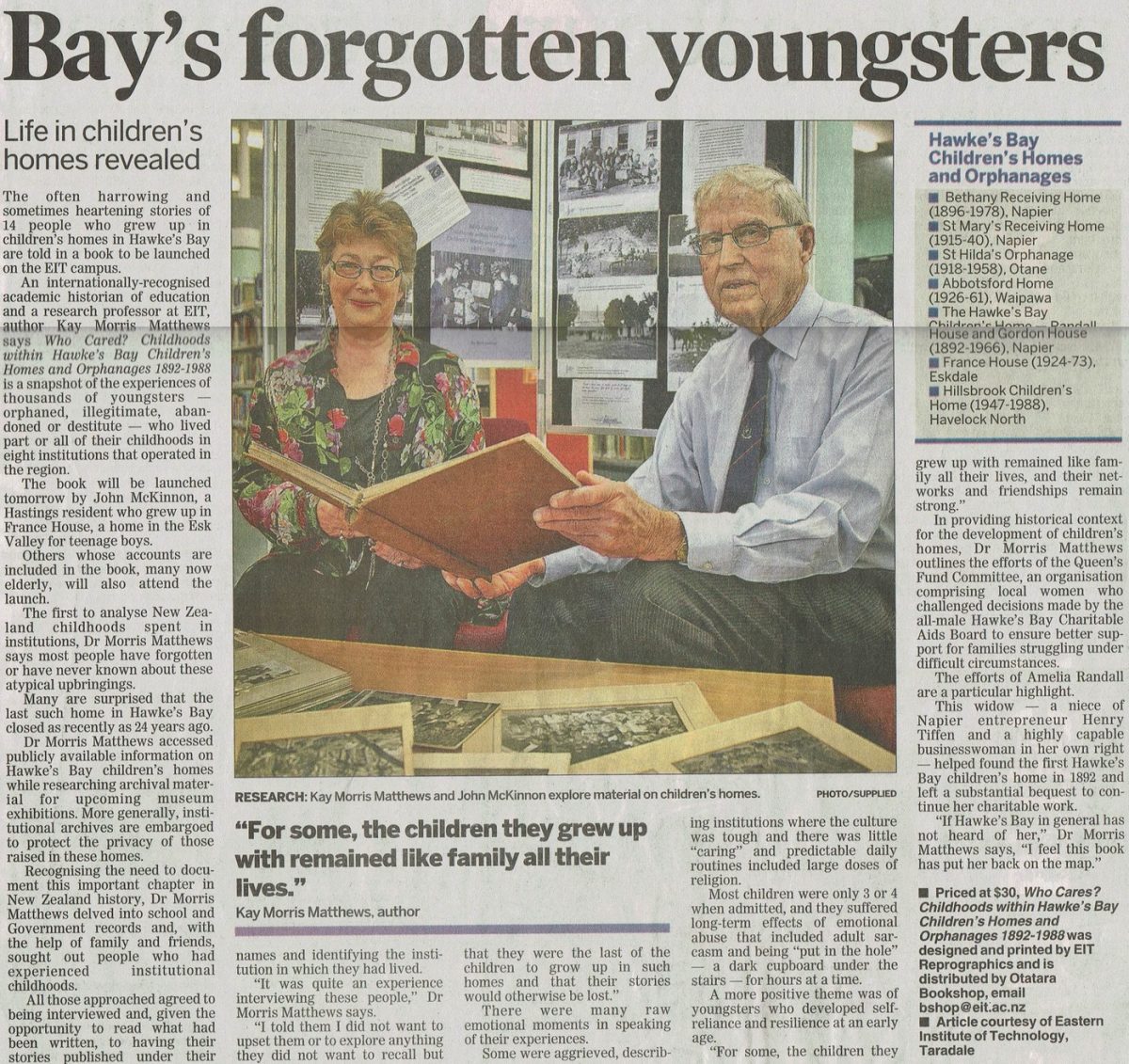Bay’s forgotten youngsters
Life In children’s homes revealed
The often harrowing and sometimes heartening stories of 14 people who grew up in children’s homes in Hawke’s Bay are told in a book to be launched on the EIT campus.
An internationally-recognised academic historian of education and a research professor at EIT, author Kay Morris Matthews says Who Cared? Childhoods within Hawke’s Bay Children’s Homes and Orphanages 1892-1988 is a snapshot of the experiences of thousands of youngsters – orphaned, illegitimate, abandoned or destitute who lived part or all of their childhoods in eight institutions that operated in the region.
The book will be launched tomorrow by John McKinnon, a Hastings resident who grew up in France House, a home in the Esk Valley for teenage boys.
Others whose accounts are included in the book, many now elderly, will also attend the launch.
The first to analyse New Zealand childhoods spent in institutions, Dr Morris Matthews says most people have forgotten or have never known about these atypical upbringings.
Many are surprised that the last such home in Hawke’s Bay closed as recently as 24 years ago.
Dr Morris Matthews accessed publicly available information on Hawke’s Bay children’s homes while researching archival material for upcoming museum exhibitions. More generally, institutional archives are embargoed to protect the privacy of those raised in these homes.
Recognising the need to document this important chapter in New Zealand history, Dr Morris Matthews delved into school and Government records and, with the help of family and friends, sought out people who had experienced institutional childhoods.
All those approached agreed to being interviewed and, given the opportunity to read what had been written, to having their stories published under their names and identifying the institution in which they had lived.
“It was quite an experience interviewing these people,” Dr Morris Matthews says.
“I told them I did not want to upset them or to explore anything they did not want to recall but that they were the last of the children to grow up in such homes and that their stories would otherwise be lost.”
There were many raw emotional moments in speaking of their experiences.
Some were aggrieved, describing institutions where the culture was tough and there was little “caring” and predictable daily routines included large doses of religion.
Most children were only 3 or 4 when admitted, and they suffered long-term effects of emotional abuse that included adult sarcasm and being “put in the hole” – a dark cupboard under the stairs – for hours at a time.
A more positive theme was of youngsters who developed self-reliance and resilience at an early age.
“For some, the children they grew up with remained like family all their lives, and their networks and friendships remain strong.”
In providing historical context for the development of children’s homes, Dr Morris Matthews outlines the efforts of the Queen’s Fund Committee, an organisation comprising local women who challenged decisions made by the all-male Hawke’s Bay Charitable Aids Board to ensure better support for families struggling under difficult circumstances.
The efforts of Amelia Randall are a particular highlight.
This widow – a niece of Napier entrepreneur Henry Tiffen and a highly capable businesswoman in her own right – helped found the first Hawke’s Bay children’s home in 1892 and left a substantial bequest to continue her charitable work.
“If Hawke’s Bay in general has not heard of her,” Dr Morris Matthews says, “I feel this book has put her back on the map.”
___________________________________________________________
Hawke’s Bay Children’s Homes and Orphanages
* Bethany Receiving Home (1896-1978). Napier
* St Mary’s Receiving Home (1915-40), Napier
* St Hilda’s Orphanage (1918-1958), Otane
* Abbotsford Home (1926-61). Waipawa
* The Hawke’s Bay Children’s Home – Randall House and Gordon House (1892-1966) Napier
* France House (1924-73), Eskdale
* Hillsbrook Children’s Home (1947-1988), Havelock North
___________________________________________________________
Photo caption – RESEARCH: Kay Morris Matthews and John McKinnon explore material on children’s homes. “For some, the children they grew up with remained like family all their lives.” Kay Morris Matthews, author
Priced at $30, Who Cares? Childhoods within Hawke’s Bay Children’s Homes and Orphanages 1892-1988 was designed and printed by EIT Reprographics and is distributed by Otatara Bookshop, email bshop[@]eit.ac.nz
Article courtesy of Eastern Institute of Technology, Taradale












Do you know something about this record?
Please note we cannot verify the accuracy of any information posted by the community.